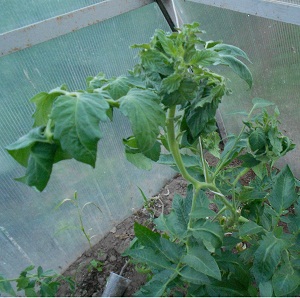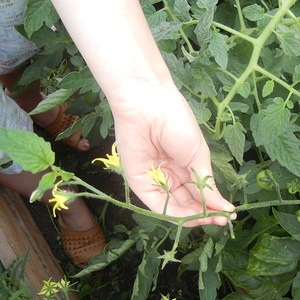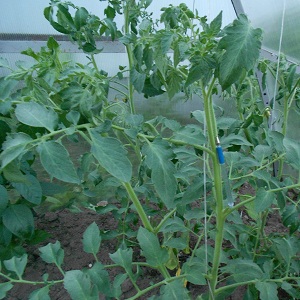Why tomatoes in a greenhouse fatten and what to do if this happens: a guide to action and useful tips
Tomatoes are one of the favorite crops of gardeners. Juicy, aromatic, tasty fruits contain calcium, magnesium, phosphorus, vitamins A, C, B. In addition, it is a rich source of potassium, which is so essential for heart health.
So, you have planted tomatoes, look after them and wait for the harvest. But time passes, the plants seem to be healthy, and the tomatoes do not appear. What's the matter? Most likely, tomatoes are fattening. From the article you will learn what fattening is, see photos of fattening tomatoes, find out how to prevent and what to do if this happens.
The content of the article
What is tomato fattening
Fatting is the process of growing green mass to the detriment of fruiting.
When tomatoes are fattened, the tops are actively growing, the plant looks powerful, but the development of flowers and the formation of fruits is suspended. This is not a disease or genetic disorder, but a consequence of improper agricultural practices. Tomatoes in the greenhouse are fattened more often than in the open field.

Why fattening tomatoes are bad
Lush fattening plants can look beautiful. But the purpose of growing tomatoes is not to decorate the garden, but to produce fruits.
You should not expect a high harvest from healed bushes, it may not be at all.
How to understand that tomatoes are fattening
There are several ways to determine that tomatoes are fattening. The bushes have a powerful thick stem, large dark green leaves, but the upper ones are twisted.
Leaves or stepsons appear from flower brushes, so-called overgrowth occurs. The clusters are formed with a large number of buds, which fall off after a while.
Reasons for fattening tomatoes in a greenhouse and how to fix the problem
There may be several reasons for fattening tomatoes, but they are all a consequence of ill-considered planting and errors in plant care.

High planting density
A high planting density reduces the amount of light on the plants. Compensating for the lack of sunlight necessary for photosynthesis, tomatoes are actively increasing their green mass. To remedy the situation, you need to carefully remove some of the leaves that prevent the normal lighting of flower brushes and ovaries.
Suboptimal temperature
The optimum temperature for the proper growth and ripening of tomatoes is 22-24 ° C during the day and 16-18 ° C at night. Pollen growth and formation cease at temperatures below 10 ° C. Temperatures above 30 ° C lead to the loss of flowers and ovaries.
To create a favorable microclimate in hot weather, the greenhouses are ventilated.
At low temperatures, additional cover of greenhouse ridges with a film is used, the side walls of the greenhouse are covered with foamed film, and the ground is covered with a film or black non-woven cloth.
Too much fertilizer
An excess of nitrogen leads to rapid growth of tops, while flowers, more like weakly colored small buds, are formed in small quantities, and the fruits are not tied. So that there is no surplus of nutrients in the soil, the soil is not fertilized with fresh manure, and fertilizing with slurry is also avoided.
High air humidity
Tomatoes do not need high soil and air moisture... With abundant watering, foliage grows, fruiting is suppressed. In addition, with frequent irrigation, the root system develops weak and unable to withstand drought.
Water the tomatoes recommend no more than 1 time a week during the period of plant growth, with mass pouring of fruits, the frequency of watering is increased up to 2-3 times a week.
Lack of light
Tomatoes are a light-demanding crop. With a shortage of sunlight, the formation and ripening of fruits is suspended, the plant spends all its strength on the growth of leaves. When planting tomatoes, you should choose non-shaded areas.
How to deal with fat gain
If the problem of fattening tomatoes has arisen, do not despair. A number of agrotechnical techniques will correct the situation.
Ban on nitrogen fertilization
After transplanting the seedlings to a permanent place, the application of fertilizers containing nitrogen, such as manure, urea, saltpeter, is stopped. An exception should be made if the plants are clearly deficient in nitrogen - they noticeably lag behind in growth, have faded leaves and elongated thin stems.
Read also:
Stable and unpretentious in care, persistent tomato "Zhenaros".
An unpretentious, but very tasty variety of "Market Miracle" tomatoes.
Air temperature regulation
To achieve the optimal air temperature (during the day - 22-24 ° С, at night - 16-18 ° С), the greenhouse is regularly ventilated. The beds are additionally insulated if necessary.
Correct feeding
During the growth period, tomatoes are fed with potassium and phosphorus.
The first root dressing is done when a 5-6 flower brush appears. Mineral preparations are used as a source of these trace elements - potassium monophosphate or superphosphate. For faster assimilation of nutrients, solutions are prepared:
- potassium monophosphate - 1 tbsp. l. for 10 liters of water;
- superphosphate - 2 tbsp. l. 10 liters of water (for better dissolution, use hot water).
The consumption of irrigation solutions is about 1 liter per one bush.
As an ambulance, foliar feeding is practiced - spraying foliage with small sprays. The dosage of potassium monophosphate in this case is 5 g per 10 liters of water.
A superphosphate solution is prepared as follows: 20 Art. l. the drug is poured into 3 liters of boiling water and insisted for a day in a warm place, stirring occasionally, then 150 ml of the resulting extract is diluted in 10 liters of water. Consumption of working solutions - 5-6 liters per 1 m2.
Suspension of watering
When signs of fattening appear, watering is stopped for about 7 days. In the future, it is worth watering tomatoes no more than once a week; during mass pouring of fruits - no more than 2-3 times a week.
Hand pollination
Tomatoes are self-pollinating plants, pistil and pollen grains are in the same flower. Flowers in the neighborhood pollinate each other.
On healed bushes, the viability of pollen grains is reduced. In addition, high humidity interferes with the spread of pollen.
To form the ovaries, manual pollination... The plants are shaken lightly so that the pollen falls off the flowers. Pollen spread is also aided by regular ventilation to circulate air in the greenhouse.
Important! The manual pollination procedure is carried out in the morning in dry weather.
Formation of bushes
In the fight against the problem of fattening, one should not neglect the methods of forming bushes or pinching. Lateral shoots formed in the leaf axils are removed.
The first time the tomatoes are stepson during the flowering period on the first flower brush. Remove stepchildren before they reach 5 cm in length by tearing or pinching. This procedure is best done in the morning.
When forming bushes, it is worth removing the lowermost leaves so that the stem remains dry and well-ventilated. In July - August, pinch the top to stop growing upward.
Additional activities
To get rid of excess moisture in the greenhouse, beds mulch, and to maintain the necessary humidity, several plastic bottles without a bottom are dug into the ground.
Hilling helps to strengthen the root system, which is held twice a season; for the first time - when small growths appear on the stem.
For the amicable formation of ovaries, microelements (magnesium, boron, iodine) are needed, therefore experienced gardeners carry out regular foliar dressing with micronutrient solutions.
Tomatoes fatten in the open field - what to do
When there are signs of fattening tomatoes in the open field, watering is stopped for 7 days. After that, root top dressing is done with potash or phosphate fertilizers. For better lighting, remove excess side shoots.
Preventive measures for fattening
In order for the fruiting of tomatoes to be timely and friendly, it is recommended to take preventive measures against fattening:
- Do not thicken the tomato planting. With an optimal planting pattern, the row spacing is 40-50 cm, and the distance between the bushes is 30-35 cm for low-growing bushes. For tall tomatoes, the width between rows is 50-60 cm and the distance between plants is 40-45 cm. It is recommended to adhere to the planting patterns for each variety, as a rule, they are indicated on the seed bag.

- Avoid shaded areas for planting tomatoes. It is better to place greenhouses in sunlit places and orient the frame in the east-west direction. So the greenhouse space will be evenly lit all day.
- After planting in a permanent place, the seedlings should not be watered for 2 weeks. In the future, tomatoes are watered no more than once a week, and after the start of mass formation of fruits - 2-3 times a week. It is necessary to moisten the soil during irrigation by at least 30 cm. Such an irrigation regime contributes to the formation of a developed root system resistant to unfavorable external factors.
- Do not overfeed plants with nitrogen fertilizers. Even in the fall, it is better to add rotted organic matter (compost, manure humus), since the fresh one will not have time to decompose during the winter, and an excess of nitrogen in the soil is guaranteed. It is not necessary to carry out nitrogen fertilizing during the growing season of tomatoes. The exceptions are cases of a clear deficiency of this substance.
- Form a bush, removing excess shoots in time. Flower brushes do not form on the stepchildren, so nutrients will be spent on the formation of excess green mass.
- Ventilate the greenhouse regularly by ensuring air circulation. This measure creates the necessary microclimate: reduces air humidity, maintains the optimal temperature - 22-24 ° C.
- Conduct regular root and foliar feeding potassium, phosphorus, micronutrient fertilizers containing magnesium, boron, iodine. During the season, 8-10 dressings are carried out. Depending on the condition of the plants, this number is decreased or increased.
Conclusion
The fattening of tomatoes is the growth of powerful tops instead of the formation of fruits. The phenomenon indicates improper care of plants, signals an excess of nitrogen in the soil, excessive watering, insufficient illumination.
When growing tomatoes, you should not get carried away with organic matter and nitrogen fertilizers; it is better not to feed tomatoes than to overfeed. They do not need a lot of moisture, watering every seven days is enough. For active fruiting, it is necessary to provide full-fledged solar illumination of the bushes - do not place the beds in the shade, do not thicken the planting, remove excess shoots in time.
Subject to all the rules of the technique of growing tomatoes, a rich harvest is guaranteed.